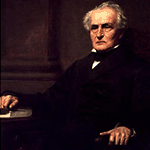
William Strong (1870-1880)
William Strong lived from 1808 to 1895.
Early Life
Strong was born in Somers, Connecticut and was the eldest of eleven children. He attended the Munson Academy in Massachusetts, and later graduated from Yale University in 1828. While studying law with Garret D. Wall, Strong taught school in Burlington, New Jersey. He then completed his legal education with a six-month course at Yale Law School. After being admitted to the bar, Strong started a legal practice in Reading, Pennsylvania.
Legal Career
Strong was elected to the United States House of Representatives as an abolitionist Democrat in 1846, serving two terms in the house. During his second term, he was the chairman of the U.S. House Committee on Elections. He returned to private practice in 1850 and did not seek reelection.
In 1857, Strong was elected to the Supreme Court of Pennsylvania as a Democrat. However, soon after taking the bench, Strong switched to the Republican Party. He resigned from the court in 1868, returning to private practice in Philadelphia.
Appointment to the Supreme Court
When a seat on the U.S. Supreme Court was vacated, Strong was among those suggested as a possible replacement. However, President Ulysses S. Grant was instead lobbied to nominate former Secretary of War Edwin Stanton for the open seat. While Stanton was successfully nominated and confirmed by the Senate, he died just four days later. On February 7, 1870, President Grant then nominated Strong, who was confirmed without a recorded vote.
Strong wrote the majority opinion in Strauder v. West Virginia (1879), an early equal protection case. Although he was regarded as an intelligent and hard-working justice, Strong never devoted much attention to constitutional matters. Strong was also one of five Supreme Court Justices to sit on the Electoral Commission of 1876, a commission convened to resolve the disputed electoral votes in the presidential election of the same year. Strong voted with the Republican majority, awarding all disputed votes to Republican candidate Rutherford B. Hayes to ensure Hayes’ presidency.
Strong served on the Supreme Court until December 14, 1880. Although he was in good health, he chose to retire as an example to several justices who were ill yet refused to give up their seats. After retirement, Strong returned to private practice and pursued religious causes until his death.
Death
Strong died in Lake Minnewaska in Ulster County, New York, on August 19, 1895. He is buried in Charles Evans Cemetery in Reading, Pennsylvania.








